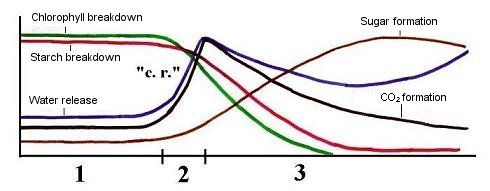- Picking, harvesting, shipping or industrial ripeness (preclimacteric)
Most fruit commences transport at the picking ripeness stage, e.g. autumn and winter varieties of pomaceous fruit, citrus fruit, bananas, pineapple and tomatoes. At this stage the fruit has a hard consistency and a green color. The high starch, pectin, acid and tannin content gives it a sharp, acidic, often astringent (mouth-puckering) taste.
- Ready-to-eat or ripe for consumption (climacteric)
The biochemical processes lead to the conversion of starch into sugar, such that the ripe fruit develops its typical sourish sweet aroma, together with a soft consistency and a species-specific color. The optimum chemical composition and thus the maximum nutritional value are achieved.
- Physiological ripeness (postclimacteric)
Decomposition processes lead to a type of autolysis (self-digestion): the flesh of the fruit becomes mealy and pasty and the flavor becomes insipid. Overripe fruit easily falls victim to mold and bacteria.
This stage is already considered overripe by the consumer.
Vegetables are generally harvested at maximum ripeness. This means that they do not undergo any quality-improving ripening during subsequent storage, making vegetables products which do not store well and are unsuited to transport over long distances.

| Figure 79: Ripening of bananas 1 - preclimacteric (green) 2 - climacteric (turners) 3 - postclimacteric (yellow) "c.r." - "climacteric rise" |